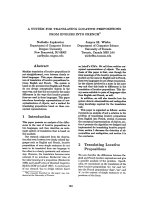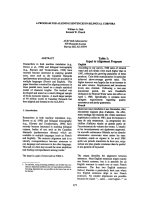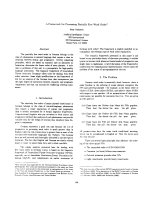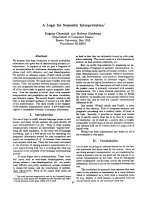Báo cáo khoa học: "A Model for Mechanical Translation" pdf
Bạn đang xem bản rút gọn của tài liệu. Xem và tải ngay bản đầy đủ của tài liệu tại đây (139.79 KB, 3 trang )
[
Mechanical Translation
, vol.4, nos.1 and 2, November 1957; pp. 2-4]
A Model for Mechanical Translation
John P. Cleave, Birkbeck College Research Laboratory, University of London*
A mathematical model for a translating machine is proposed in which the transla-
tion of each word is conditioned by the preceding text. The machine contains a
number of dictionaries where each dictionary represents one of the states of a
multistate machine.
* Now at Southampton University, Southampton,
England.
translation and also to a simple coding expres-
sed by the table
which may be regarded as a dictionary. If the
input data S and the output data are punched
tape on an automatic computer with unidirec-
tional reading and printing devices, then the
above transformation is effected by a single-
state machine.
A word-for-word translation in which the
equivalents selected for an input word depend
upon the context of the preceding text is repre-
sented by a compound coding, effected by a
multistate machine. This type of transforma-
tion, called "conditional" is effected by the
rules:
A Model for MT 3
where r = 1, 2
We suppose that the
sequence of rules provides a course of action
for each possibility. ( The exact conditions on
the number of rules will not be investigated
here, but it should be noted that the rules are
in a certain order.) If we let the sign ' »' de-
note 'precede in the message' then rule r can
be abbreviated to
Instead a connected series of dictionaries may
be constructed by the following method, which
is best illustrated by supposing one conditional
rule only. Suppose the sequence of rules is
The sequence of dictionaries will contain some
entries which will refer the operator to another
dictionary. If we let, say
The last n rules cover those instances where
a datum of S
1
is not preceded by its relevant
context. These rules cannot be reduced to the
simple dictionary with a finite number of en-
tries as in the previous simple transformation.
4 J. P. Cleave
If the conditional rules are effected by a com-
puting machine, each dictionary represents a
state of the machine. A transformation which de-
pends upon context therefore can be represented
as a compound coding or a multistate machine.









